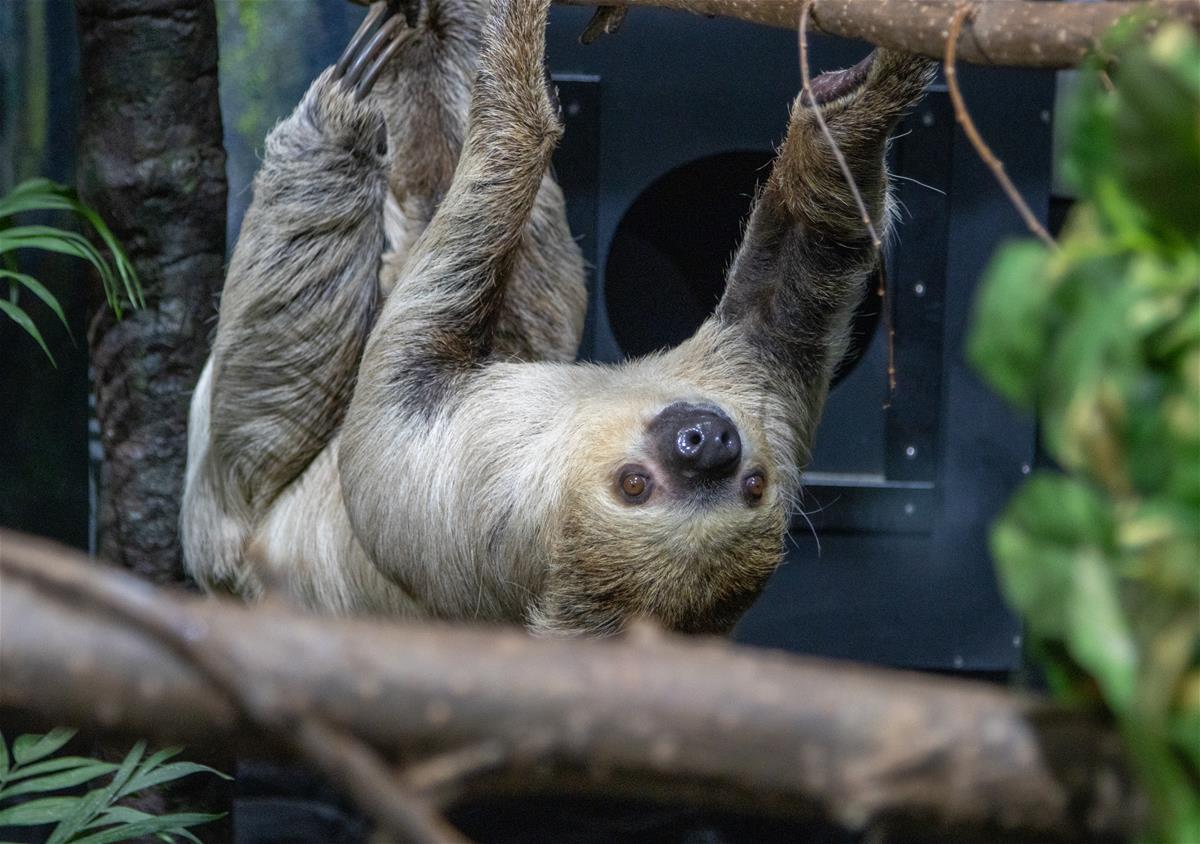Two-toed sloth
Choloepus didactylus
Order: Edentata
Family: Bradypodidae
Genus: Choloepus
The long grey-brown coat consists of long guard hairs and short under-fur. The face is lighter; the shoulders and top of head are the darkest. This species has two digits on the forelimbs and three on the hind limbs. Fingers and toes are encased for most of their length in a sheath of skin and muscle terminating in huge hooked claws, which are 7.5 cm long. The tail is absent or vestigial. An adult sloth is 60 to 64 cm in length and weighs nine kilograms. They have a four chambered stomach, for digesting plant matter. Sometimes digestion is slow enough to take up to a month. The two toed sloth is nocturnal.
Conservation Status: IUCN
Distribution
Widely distributed through out the tropical rain forests of Central and South America, including portions of Brazil and Peru. It is often referred to as the southern two-toed sloth. Two species of sloth belong in this genus, Choloepus didactylus and Choloepus Hoffmanni.
Habitat
HABITAT: Forest canopy. It is strictly arboreal, staying high in the canopy of the tropical rain forests, and maintaining a range of about 10-acres.
Diet
They feed primarily on vegetation, including berries, leaves, small twigs, and fruits; cropping the leaves with their lips. On occasion sloths have been known to eat insects and other small prey. They obtain water from vegetation and by lapping dew.
Reproduction
The animal spends most of its life upside down moving very slowly through the trees. In coupling, both animals hang from a branch by their forelimbs, face to face. The breeding season is March and April. The gestation period is six months. When giving birth the animal hangs from a branch, the young emerges head first without an embryonic membrane and proceeds to pull itself up the mother’s belly; in fact assisting its own birth. A newborn sloth is 25 cm long and weighs 300 to 400 grams. The infant is carried on its mother’s upturned belly. It does not become independent for nine months. Females reach sexual maturity at three years of age and males at four or five years.
Adaptation
External adaptations to its upside down arboreal existence are: its long, sharp, powerful claws, its long guard hairs, which part along its belly and hang downwards to divert tropical downpours, and its protective colouration. Hanging with all four limbs close together, the animal looks like a bunch of dried leaves. The guard hairs have longitudinal grooves in which single cell algae live, giving the animal a green sheen, a further protective colouration. In the long coat, mites, beetles and three species of moths live, apparently on the algae. Internally, the liver, spleen and pancreas have moved one hundred thirty-five degrees downward from normal mammal positions. Sloth have no incisor or canine teeth; Their cheek teeth (five above and four below) have open pulp cavities and grow throughout life. To compensate for a lack of sharp teeth, Choloepus didactylus has hardened lips which act to shear and crop leaves. The body temperature, normally thirty-two degrees Celsius, varies following the ambient temperature. A single exposure to thirty-five to forty degrees starts a fatal rise in temperature. They can thus only live in tropical rain forests where temperatures are relatively stable. Females appear to have better temperature control while pregnant. Their muscle bulk is relatively small. Most mammals have forty-five percent muscle bulk whereas the sloth has only twenty-five percent. This suggests a reason for low-temperature and poor-temperature regulation. The digestive process is slow in their large, complex stomachs. They descend to the ground only to defecate usually about once a week. The bladder is very large and surrounded by blood vessels, which suggests that the organ may be used for water storage. They have great difficulty standing. If they have to move on a flat surface, they reach out and get a claw hold to pull themselves forward. The sloth has the ability to heal from wounds that would otherwise be fatal to other animals.
Threats to Survival
Habitat loss, large birds of prey and carnivores that can climb. On the ground sloths do not have great defenses against large cats and other predators.















